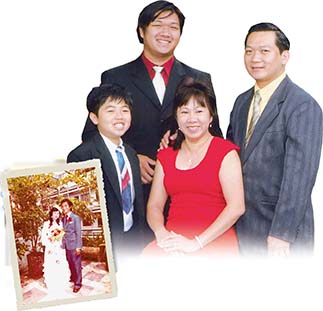SECTION 5: Americans Look to the Future

▲ The Trans today (above) with their sons and at their wedding in Vietnam (left).
WITNESS HISTORY  AUDIO
AUDIO
Finding the American Dream
In 1990, Eddie (Duc) and Linda (Lieu) Tran left Vietnam with their young son to start over in Columbus, Ohio. Sponsored by Linda’s brother, who had fled Vietnam by boat during the fall of Saigon in 1975, the Trans were aware of the obstacles that faced them in their new country.
“Learning the English language and finding jobs were our biggest challenges. We listened to the radio and tried to converse as much as possible with our co-workers to learn English. Everyone was helpful. And we were determined never to receive welfare. Linda got a job as a tailor ten days after we arrived. I owned a manufacturing business in Vietnam, but it took me six months to get employed here. Times were hard, and we still work 12-hour days in our restaurant now. But the best thing about this country is freedom. If you work hard, you can achieve the American dream.”
—Eddie and Linda Tran, 2005
Objectives
- Analyze the impact of immigration on American society.
- Summarize the causes and effects of changing demographics.
Terms and People
- Immigration Act of 1990
- bilingual education
- Immigration and Control Act of 1986
- affirmative action
- Violence Against Women Act
- privatize
NoteTaking
Reading Skill: Identify Supporting Details Record supporting details about the changing American society in a table like this one.
| Immigration | Demographics |
|---|---|
|
|
Why It Matters As the twenty-first century dawned, American society looked very different from the way it had during the previous century. It also faced different challenges. As the nation entered the new millennium, it sought ways to preserve its heritage while at the same time adapting to rapid social, political, and technological change. Section Focus Question: How was American society changing at the beginning of the twenty-first century?
Immigrants Shape a Nation
For two centuries, American protection of religious and personal freedom, along with opportunities for social and economic mobility, has attracted huge numbers of immigrants. Over time, however, the nature of immigration has changed.
Immigration Policies Change
For years, the government limited immigration to mainly northern and western Europeans. In the 1960s, however, laws began to relax immigration limitations. The Immigration Act of 1990 increased quotas by 40 percent and eased most remaining restrictions. As a result, the period from the 1990s to the 2000s saw the largest numbers of immigrants in the country’s history. During that time, almost one million immigrants arrived in America each year from all over the globe, representing a wide variety of cultures and religions. Today, immigrants account for more than 10 percent of the total American population.




